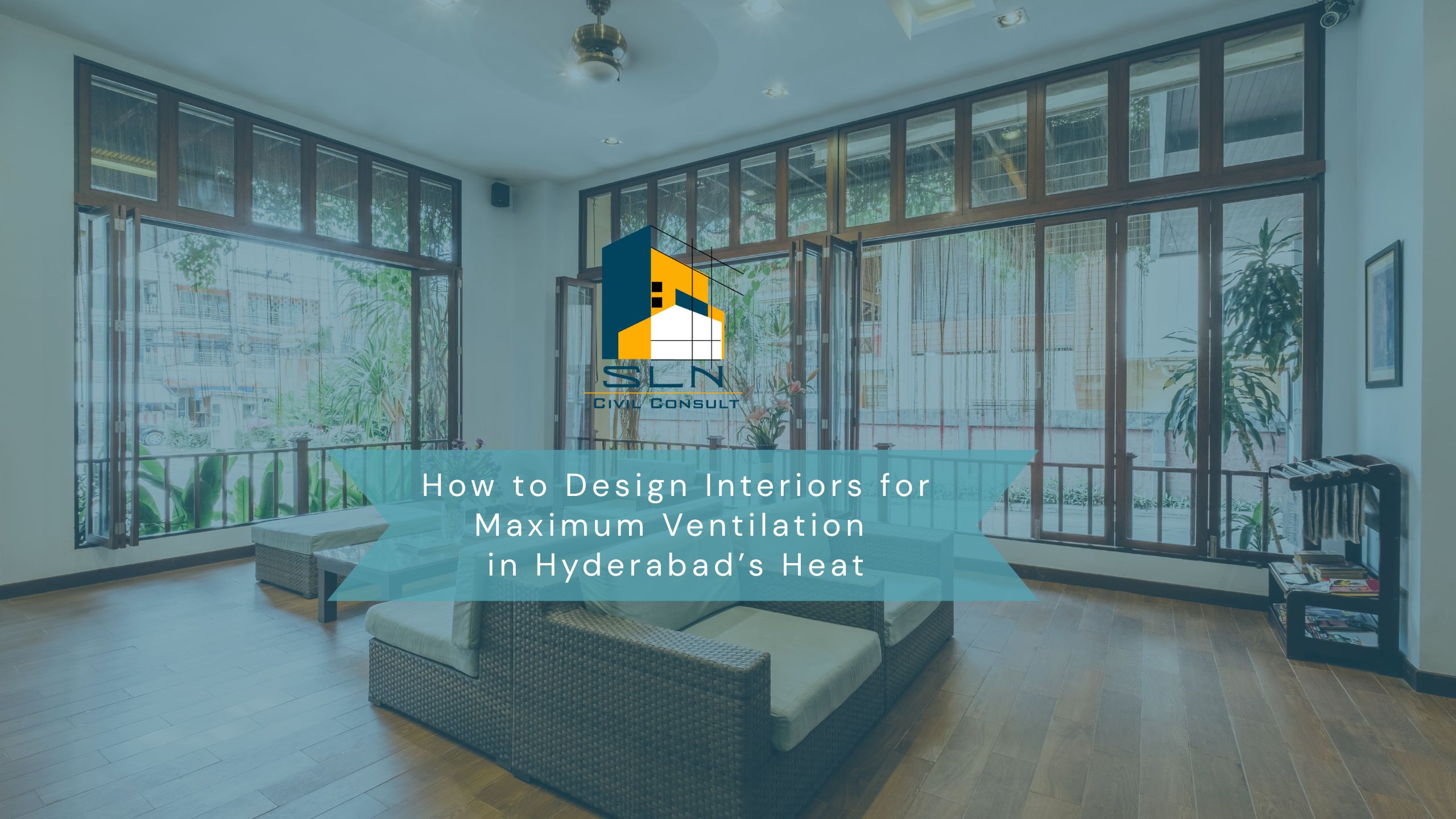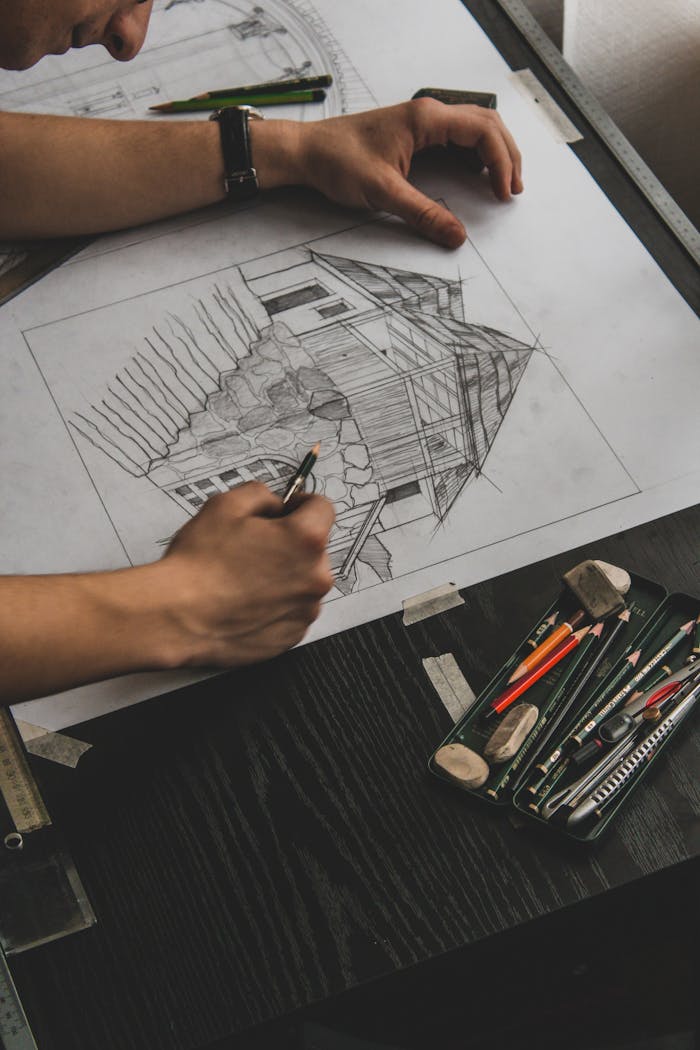Hyderabad, known for its rich culture and rapid urban development, also grapples with a blazing hot summer. With temperatures soaring above 40°C between March and June, designing a naturally ventilated home is more than just comfort—it’s a necessity. So how do you beat the heat without driving up your electricity bill?
In this blog, we’ll show you how to design interiors for maximum ventilation in Hyderabad’s heat using practical strategies, layout changes, material choices, and expert-approved tips to keep your home naturally cool.
Why Ventilation is Crucial in Hyderabad
Before jumping into the design ideas, it’s important to understand the specific needs of Hyderabad’s dry tropical climate:
- High summer temperatures (March to June)
- Low humidity
- Occasional dust storms
- Short monsoon season (June to September)
These conditions mean homes should be built to promote airflow, limit solar gain, and prevent heat buildup.
1. Orientation of the House Matters
One of the first factors in designing for ventilation is deciding how your home faces.
- East-West facing homes can get very hot due to prolonged sun exposure. Instead, North-South orientation helps reduce direct sunlight, especially on walls.
- Avoid large glass windows on the west side.
- Use sunshades and verandahs to block harsh afternoon rays.
Pro Tip: Use compass-based layout tools while planning your floor plan.
2. Cross Ventilation: The Golden Rule
Cross ventilation is the process of allowing fresh air to flow from one side of the room to the other. Here’s how:
- Place windows on opposite or adjacent walls in each room.
- Use louvered windows or ventilators to allow hot air to escape.
- Position furniture in a way that does not obstruct air flow.
Example:
A living room with windows facing north and south will create a natural wind tunnel, pushing stale hot air out and bringing in fresh air.
3. Smart Window Design
Windows are not just for light—they’re crucial for ventilation too.
- Jalousie windows (slatted glass panels) allow airflow even when partially closed.
- Use mesh panels to keep bugs out while allowing breeze.
- Avoid sealing windows with dark, heat-absorbing curtains. Instead, use sheer cotton or khadi drapes.
Material Tip: Choose wooden frames over metal to avoid heat conduction.
4. Ventilated False Ceilings
False ceilings can trap heat if not designed wisely. Instead:
- Use gypsum boards with ventilation gaps.
- Create air escape routes between the ceiling and roof.
- Consider ventilated attic vents or turbine ventilators.
This not only reduces heat buildup but also lowers your AC usage.
5. Interior Layout Planning
The internal arrangement of spaces plays a vital role in how air moves.
- Place kitchen and bathrooms on the western or southern end to keep heat and moisture away from living zones.
- Avoid too many partition walls. Use glass, open shelves, or screens instead.
- Design open corridors or courtyards inside the home for air circulation.
Open Floor Plans:
- Ideal for small Hyderabad homes.
- Keep airflow unrestricted.
- Combine dining + living + kitchen with adjustable partitions.
6. Natural Materials for Interiors
Cooler homes begin with the right materials:
- Flooring: Go for terracotta tiles, natural stone (like Kadapa), or vitrified tiles that don’t retain heat.
- Walls: Lime plastered or mud walls stay cooler than cement.
- Furnishings: Use cotton, linen, bamboo, or jute.
Avoid leather, velvet, or synthetic materials which trap heat.
7. Cooling Colors & Decor Choices
Believe it or not, colors can influence perceived temperature.
- Use light, pastel shades like mint, sky blue, beige, and white.
- Opt for minimalist decor to avoid heat-trapping clutter.
- Decorate with indoor plants like snake plant, money plant, or palms that naturally purify and cool the air.
8. Smart Furniture Placement
Avoid bulky furniture in the airflow path. Follow these tips:
- Keep furniture at least 6 inches from walls.
- Use open-back or legged furniture for circulation under and around.
- Install foldable or multipurpose furniture to declutter.
9. Roof and Wall Insulation Hacks
While this is more architectural, it has a huge impact on interiors:
- Use white reflective tiles on the terrace.
- Install green roofing or clay jaalis (perforated bricks).
- Add external wall insulation for western-facing walls.
All these reduce heat transmission into the home.
10. Passive Cooling Techniques
- Water fountains or indoor water bodies can cool down interiors naturally.
- Use wind catchers or solar chimneys to redirect hot air out.
- Include ventilated stairwells or skylights with vents.
11. Avoid These Ventilation Mistakes
- Blocking windows with wall units
- Choosing dark interiors
- Skipping ceiling fans
- Closed floor plans
- Glossy floors that reflect heat
12. When to Consult an Expert
If you’re building or renovating, hire an architect or interior designer with local climate experience. SLN Civil Consult specializes in Hyderabad-specific residential design that ensures:
- Maximum airflow
- Energy-efficient planning
- Long-term comfort
FAQs
Q1. Which direction should windows face for better ventilation in Hyderabad?
North and South-facing windows offer the best cross-ventilation without direct heat exposure from the sun.
Q2. What materials are best for cool flooring in Hyderabad?
Terracotta, Kadapa stone, and vitrified tiles are best as they don’t absorb much heat.
Q3. Can plants help improve indoor air quality and cooling?
Yes. Plants like areca palm, snake plant, and aloe vera cool the environment naturally and purify the air.
Q4. Is it better to use AC or natural ventilation in Hyderabad summers?
ACs can be expensive and energy-intensive. A well-ventilated home reduces the need for constant AC use.
Q5. How can I improve airflow in a small apartment?
Use open layouts, lightweight furniture, and ceiling fans. Avoid sealing all windows or placing heavy curtains.
By making these smart design choices, you can enjoy a cool, comfortable, and energy-efficient home even in the harshest Hyderabad summers. If you’re planning a new home or revamping your interiors, make ventilation a priority — your future self will thank you!
Want help designing your home for Hyderabad’s heat? Contact SLN Civil Consult today!



